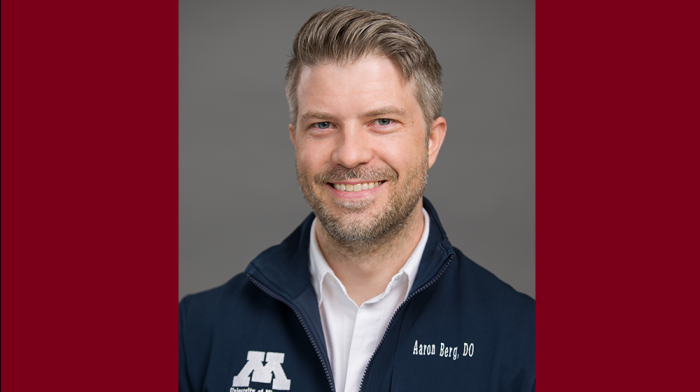
Nearly every day, Aaron Berg, DO, an anesthesiologist with University of Minnesota Physicians (M Physicians) and assistant professor at the University of Minnesota Medical School, finds himself asking questions, questions that help him and his team provide the best care possible for each patient they see.
It’s an approach that often lands him on multiple lists naming top doctors across Minnesota, as his colleagues continue to recognize the difference he makes for others.
For Dr. Berg, they open up conversations with patients and colleagues that are the foundation of the care he gives.
“Communication is care”
Dr. Berg starts his day by talking with patients who have an operation scheduled that morning. It’s one of his favorite parts.
“The more you talk with patients, you understand their worries, which helps you figure out how you can best care for them,” he says. Connecting with patients also helps Dr. Berg communicate with their care teams to make sure everyone understands what their patients need.
Nearly every morning, though, there’s a curveball. Whether it’s changes in scheduling or a more emergent situation, Dr. Berg makes sure his team knows right away, so they can adjust their plans accordingly.
“Communication is care,” he says, “I think about it all the time.”
That’s one of Dr. Berg’s guiding principles–communication–in his care for patients, teaching for learners and also in the research he conducts to improve healthcare across Minnesota.
Maybe not a poke, nor a burn
One of the challenges anesthesiologists like Dr. Berg face in their research is how to objectively measure pain. For Dr. Berg himself, he’s focused on how to measure patients’ pain if they need certain kinds of pain relief medicines, like opioids, following an operation.
“When talking about opioids and pain scores, it’s really not a fun thing to research, because pain scores are extremely subjective,” he says. “My 10 isn’t your 10. Everyone has different thoughts of what a pain score is, that variability makes it difficult to research.”
One of the main things researchers look for when measuring pain is if there is a change in pain scores for large numbers of patients, and Dr. Berg is looking to develop a better, more objective way to assess pain that can help researchers develop more beneficial pain treatments.
Another significant part of Dr. Berg’s research also focuses on–you guessed it–communication.
Oftentimes, Dr. Berg says he hears clinicians who are about to give a patient a local anesthetic say that it’s “just a poke and a burn.” But he can’t help but wonder if those words influence the patient’s perspective on what’s about to happen.
“What if we say, ‘Hey, this is numbing medication, you know, to help the rest of the procedure go easier.’ Does that change their perception on how their pain was during the procedure or how they felt about it?”
Dr. Berg envisions applying this research to help patients who undergo procedures that may typically lead to an opioid prescription to see if a better linguistic or multimodal pain approach could help them experience a different level of need for it.
This curiosity is something that Dr. Berg aims to instill in the students, residents and fellows he trains at University of Minnesota Medical Center as director of the U of M’s regional anesthesia and ambulatory medicine fellowship. After all, it’s what his mentors at the U of M did for him.
“If you would have asked my co-residents, including my wife, if I would’ve gone into academia or research, I probably would have been last on their list,” he remembers. “But the department here where I trained has been really good at asking us ‘what are the clinical questions that keep you up at night?’ and then being really supportive in helping us answer those questions.”
Those are what guide Dr. Berg’s practice, as he always looks to what day-to-day differences he can continue to make for patients and their care.